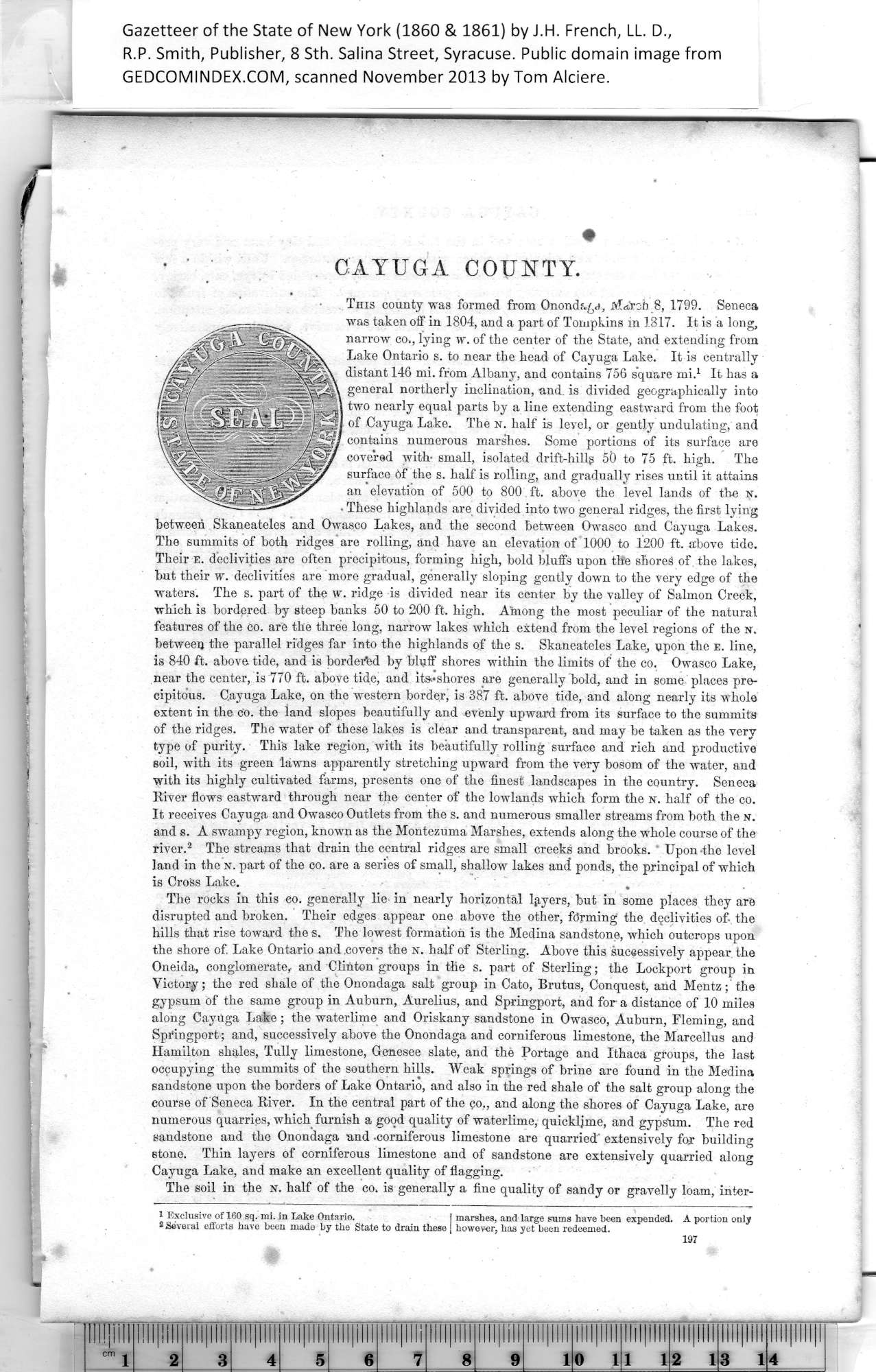|
CAYUGA COUNTY.
This county was formed from Onondaga, March 8, 1799. Seneca
was taken off in 1804, and a part of Tompkins in 1817. It is a long,
narrow co., lying w. of the center of the State, and extending from
Lake Ontario s. to near the head of Cayuga Lake. It is centrally
distant 146 mi. from Albany, and contains 756 square mi.1 It has a
general northerly inclination, and. is divided geographically into
two nearly equal parts by a line extending eastward from the foot
of Cayuga Lake. The n. half is level, or gently undulating, and
contains numerous marshes. Some portions of its surface are
covered with- small, isolated drift-hillg 50 to 75 ft. high. The
surface of the s. half is rolling, and gradually rises until it attains
an elevation of 500 to 800 ft. above the level lands of the n.
. These highlands are divided into two general ridges, the first lying
between Skaneateles and Owasco Lakes, and the second between Owasco and Cayuga Lakes.
The summits of both ridges are rolling, and have an elevation of 1000 to 1200 ft. above tide.
Their e. declivities are often precipitous, forming high, bold bluffs upon the shores of the lakes,
but their w. declivities are more gradual, generally sloping gently down to the very edge of the
waters. The s. part of the w. ridge is divided near its center by the valley of Salmon Creek,
which is bordered by steep banks 50 to 200 ft. high. Among the most peculiar of the natural
features of the co. are the three long, narrow lakes which extend from the level regions of the n.
between the parallel ridges far into the highlands of the s. Skaneateles Lake, upon the e. line,
is 840 ft. above tide, and is bordei'ed by bluff shores within the limits of the co. Owasco Lake,
near the center, is 770 ft. above tide, and it&* shores are generally bold, and in some places pre¬
cipitous. C.ayuga Lake, on the western border, is 387 ft. above tide, and along nearly its whole
extent in the Co. the land slopes beautifully and evenly upward from its surface to the summits
of the ridges. The water of these lakes is clear and transparent, and may be taken as the very
type of purity. This lake region, with its beautifully rolling surface and rich and productive
soil, with its green lawns apparently stretching upward from the very bosom of the water, and
with its highly cultivated farms, presents one of the finest landscapes in the country. Seneca
River flows eastward through near the center of the lowlands which form the n. half of the co.
It receives Cayuga and Owasco Outlets from the s. and numerous smaller streams from both the n.
and s. A swampy region, known as the Montezuma Marshes, extends along the whole course of the
river.2 The streams that drain the central ridges are small creeks and brooks. Upon the level
land in the n. part of the co. are a series of small, shallow lakes and ponds, the principal of which
is Cross Lake. . .
The rocks in this co. generally lie in nearly horizontal layers, but in some places they are
disrupted and broken. Their edges appear one above the other, forming the declivities of- the
hills that rise toward the s. The lowest formation is the Medina sandstone, which outcrops upon
the shore of Lake Ontario and covers the n. half of Sterling. Above this successively appear the
Oneida, conglomerate,- and Clinton groups in the s. part of Sterling; the Lockport group in
Victory; the red shale of the Onondaga salt group in Cato, Brutus, Conquest, and Mentz; the
gypsum of the same group in Auburn, Aurelius, and Springport, and for a distance of 10 miles
along Cayuga Lake; the waterlime and Oriskany sandstone in Owasco, Auburn, Fleming, and
Springport; and, successively above the Onondaga and corniferous limestone, the Marcellus and
Hamilton shales, Tully limestone, Genesee slate, and the Portage and Ithaca groups, the last
occupying the summits of the southern hills. Weak springs of brine are found in the Medina
sandstone upon the borders of Lake Ontario, and also in the red shale of the salt group along the
course of Seneca River. In the central part of the co,, and along the shores of Cayuga Lake, are
numerous quarries, which furnish a good quality of waterlime, quicklime, and gypSum. The red
sandstone and the Onondaga and -corniferous limestone are quarried' extensively for building
stone. Thin layers of corniferous limestone and of sandstone are extensively quarried along
Cayuga Lake, and make an excellent quality of flagging.
The soil in the n. half of the co. is generally a fine quality of sandy or gravelly loam, inter-
197
1
Exclusive of 160 sq. mi. in Lake Ontario. | marshes, and large sums have been expended. A portion only
2
Several efforts have been made by the State to drain these [ however, has yet been redeemed.
|
